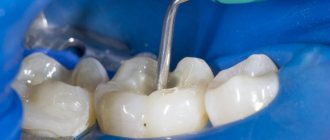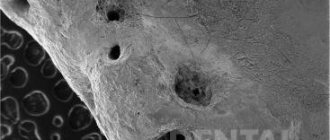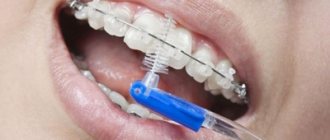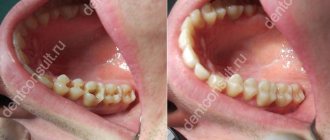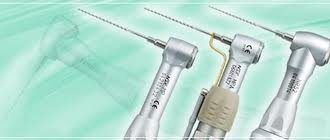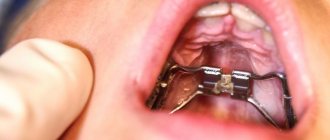Is it possible to treat teeth if you have a cold?
If the high temperature is caused by ARVI, herpes or other infectious diseases, then it is better to reschedule the appointment. The body at this moment is weakened and tuned to eliminate the disease, which means that the recovery process after dental treatment will be delayed. If you have a runny nose or cough, it will be difficult to sit in the dental chair during treatment. In addition, there is a high risk of spreading infection to the staff and other patients of the clinic.
However, there are situations when treatment cannot be delayed. In this case, you need to consult with your doctor, preferably by phone. He will decide whether to subject the weakened body to dental intervention or not.
How to set up a child for dental treatment?
Since baby teeth are somewhat different in structure from permanent teeth (they have thinner enamel and dentine layers, a larger pulp chamber, enamel wears out faster, etc.), and also have a relatively short lifespan, dental treatment in children has a number of features. Since the enamel wears off quickly, the filling material is not too hard so that over time the filling does not destroy the walls of the teeth and does not protrude beyond the edges of the tooth, interfering with normal chewing.
if the infection has affected only the enamel, it is possible to carry out remineralization therapy or treat caries using Icon technology, which involves the use of a special composite material that reliably closes and seals the carious cavity. However, it must be taken into account that this technology is not recommended for use in children under 3 years of age and cannot be used for cervical caries.
In cases where the replacement of milk teeth with permanent ones is still far away, and the dental tissues are already thoroughly destroyed or the tooth needs to be removed, special children's prosthetics are used using crowns without grinding.
Despite the fact that modern dentistry practices exclusively painless dental treatment for children, not every child is ready to trust a doctor. Moreover, the younger the child, the more difficult it is to negotiate with him and convince him to open his mouth in the dental chair. Experienced doctors have long known how to prepare a child for dental treatment:
- The use of distracting elements: bright design of the office, the presence of a TV, an unusual robe at the dentist, toys - all this helps to distract the baby, divert his attention from the upcoming procedure and give him time to calm down.
- Use of colored fillings: when a child has the opportunity to independently choose the color of the filling, treatment procedures can easily be turned into a game.
- Presence of parents: often the presence of parents in the office significantly calms the baby and sets him up to cooperate with the doctor.
- Application anesthesia: pre-treatment with a special anesthetic gel before anesthetic injection and further procedures eliminates any painful sensations.
If the baby still does not cooperate, and treatment is necessary, you can offer parents the option of having all dental procedures performed under anesthesia or intravenous sedation. In a good clinic, these methods are absolutely safe for the child’s body.
What if the cause of the elevated temperature is not a cold?
Often, an increase in temperature can be associated with inflammatory diseases in the oral cavity. For example, a cyst could form in a tooth or gum - a cavity filled with fluid. And elevated temperature is nothing more than the body’s reaction to protect itself from the spread of infection.
In an advanced state, the cyst affects neighboring teeth, so if you notice such symptoms, you need to consult a dentist.
By the way, a dental cyst is diagnosed using an x-ray - this is one of the reasons why it is necessary to undergo regular check-ups with a doctor. Treating the cyst at an early stage will protect you from possible complications, including tooth extraction.
What to do if the temperature does not drop
In some cases, doctors do not prescribe treatment for patients with a prolonged increase in temperature after pneumonia, but only monitor them - often the temperature helps to increase metabolism and fight the residual effects of the disease. Additionally, physiotherapeutic procedures are prescribed in the form of warming up the chest area, magnetic therapy, UHF, electrophoresis, therapeutic exercises and breathing exercises, which help speed up the restoration of respiratory function and help improve immunity. Doctors cannot say exactly how long the elevated temperature will last - it depends on the state of the patient’s immunity, the severity of the disease, and the general condition of the patient’s body.
Often the cause of elevated temperature is ineffective treatment, when microorganisms become resistant to antibacterial therapy, and the course of the disease becomes chronic. Certain types of fungi and bacteria have the ability to transform into the L-form when the microorganisms are in a “dormant” state until favorable conditions occur. Decreased immunity, hypothermia, viral attack and other conditions lead to the activation of such microorganisms, which again turn into the L-form state when antibiotics enter the body. The next time the immune system is suppressed, the bacteria become active again. Constant inflammatory processes with decreased immunity are typical for children; in adults, the chronic form of the disease is provoked by bad habits, difficult working conditions, and high air pollution in the workplace.
Doctors at the Yusupov Hospital provide assistance using innovative methods for treating respiratory diseases. At the Yusupov Hospital you can undergo diagnostics, effective treatment and rehabilitation after illness. You can make an appointment with a qualified doctor by phone.
Author
Alexander Vyacheslavovich Averyanov
Pulmonologist, MD, professor
Temperature after dental treatment
A slightly elevated temperature after dental treatment is a normal reaction to intervention in the body’s tissues, especially after treatment of complex diseases (pulpitis, periodontitis). Sometimes weakness and drowsiness may appear, which can be relieved with antipyretics, but you should not get carried away with them.
If three days have passed after treatment and the fever does not go away, you should consult a doctor: he will conduct an additional examination and prescribe the necessary treatment.
Root perforation
Not so long ago, the treatment of chronic pulpitis and periodontitis was carried out somewhat differently. Removing the filling material was considered the correct approach. Now experts are trying not to do this. In most cases, a tooth hurts after cleaning the canal precisely because the filling material is removed beyond the apex of the root.
Such a doctor’s mistake during treatment is made for several reasons:
- insufficient provision of the dental office with modern equipment;
- if the channel length was determined incorrectly;
- the use of a mechanical device to fill prepared holes at high speeds;
- disturbance in canal processing (absence of an apical ledge);
- resorption of the root apex, formed under the long-term influence of the inflammatory process.
For whatever reason, the material is removed outside the stabilization system of the unit, this always provokes post-filling pain. Most often, accompanying symptoms are increased body temperature and swelling of the gums around the tooth.
A tooth may hurt after treatment due to the breakage of an endodontic instrument during canal cleaning. If the doctor does not remove this part, but simply fills the cavity, then after some time or immediately after the anesthesia wears off, the patient will experience discomfort.
If a piece of the instrument remains in the canal, the doctor is unable to remove the nerve completely. Rinse with antiseptic solutions will also not work. As a result of such endodontic treatment, the root will either remain sensitive or become inflamed over time. The infectious focus will signal itself not only by pain, but also by swelling and increased temperature.
Dentists often make this mistake even in modern clinics. Everything is explained by the replacement of hand tools with mechanical equipment. Without sufficient experience, using a rotating tip when cleaning canals, the doctor may damage the integrity of the wall.
Usually at this moment the patient, even after anesthesia, feels pain reminiscent of an injection in the gum. In this case, the tooth begins to bleed heavily.
If the root is perforated, the doctor must “patch” the hole with a special paste containing calcium. If these manipulations are not carried out, the tooth will become very painful after the anesthesia wears off.
The main requirements for such filling materials are dense, hermetically sealed filling of the canals, chemical inertness (the material should not dissolve under the influence of body fluids), radiopacity (it should be clearly visible in the picture). Today, the following types of materials are used for filling dental canals:
- Solid fillers (fillers). These include gutta-percha (a latex processing product), silver and titanium pins. Silver pins have recently been rarely used, since despite their good antibacterial properties they have a significant drawback - they do not provide complete tightness.
- Polymer and natural pastes (sealers). A more preferable option is polymer sealers, which adhere better to the walls, do not stain dental tissue and do not dissolve when interacting with tissue fluids.
- Glass ionomer cements. Good adhesion and radiopacity, high biocompatibility and minimal shrinkage are the main positive qualities of such materials. They also have significant drawbacks: low strength, which is why such fillings are short-lived and not designed for serious functional loads.
- Cements with calcium hydroxide. Non-toxic, biocompatible, radiopaque materials that exhibit minimal shrinkage, are easily removed if necessary and have bactericidal properties. However, they are considered not too strong and can break under heavy loads on the dental crown.
- Polydimethylsiloxanes. Modern reliable sealants with good therapeutic and operational parameters. Perhaps their only drawback is that this is a new product on the dental market and experience in using such materials has not yet been accumulated. There is no reliable information yet about the experience of patients after such treatment.
Just 10-20 years ago, the main method of filling dental root canals was to fill them with one type of cement. This is a very simple and not labor-intensive method, but for the patient it has a lot of disadvantages: the channels are filled poorly and unevenly, voids appear in which microbial infection can develop. In addition, such cements quickly shrink and the canals soon have to be re-treated.
DETAILS: Nurofen for teething without fever dose
Modern dentistry offers completely different filling methods:
- Depophoresis is the hardware introduction of medicinal and filling materials into the root canal. The technique allows you to effectively fill even curved and hard-to-reach canals.
- Obturation with thermophiles (plastic carriers coated with gutta-percha). A fast, fairly simple and reliable method, which still has the disadvantage of the possibility of material being removed beyond the root tip.
- Filling with gutta-percha pin.
- Lateral condensation is a dense filling of the canals with gutta-percha pins coated with a hardening sealer. A fairly reliable method, however, when using it there is a high risk of tooth root fracture.
- Thermomechanical (sometimes also called rotating condenser sealing) condensation. Recently, it has been used very rarely due to the high risk of complications.
- Vertical condensation of heated gutta-percha. A rather complex and lengthy, but at the same time reliable and durable filling method.
- Injection filling with hot gutta-percha.
- Injection of heated gutta-percha using the continuous wave method. One of the options for vertical condensation, characterized by greater simplicity and at the same time sufficient reliability and tightness of filling the channel.
- Thermoplastic injection of hot gutta-percha. A simple and fast method, which, however, does not always make it possible to densely fill the lateral tubules.
- E{amp}amp;Q Plus is a mixed technique using an injection gun to inject gutta-percha into the canal.
Improperly sealed canal
Unlike the reason discussed earlier, pain in this case does not occur immediately. If the canal is not completely filled with paste, over time bacteria multiply in its voids, causing inflammation.
DETAILS: Inflammation of the gums: how to treat at home, inflamed gums near the tooth or under the crown, causes
Discomfort begins to bother the patient after several months or even years. Most often, people complain that their teeth hurt after cleaning their canals when pressing or biting on hard food.
Incorrect treatment is dangerous because for a long time a person does not realize that an infectious focus is maturing inside the body. If the error is corrected in a short time, the pain quickly goes away. When a patient lives with such a tooth for a long time, a granuloma or cyst forms at the apex of the root. These formations require separate treatment, perhaps even surgery.



